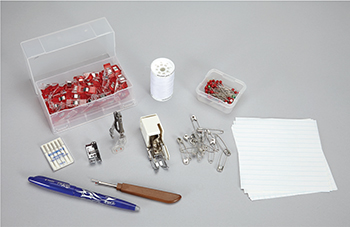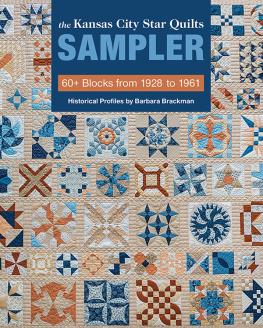Thank you for purchasing this Martha Pullen eBook.
Sign up for our newsletter and receive special offers, access to free content, and information on the latest new releases and must-have crafting resources! Plus, receive a coupon code to use on your first purchase from Store. MarthaPullen.com for signing up.
or visit us online to sign up at
http://marthapullen.com/ebook-promo
Table of Contents

INTRODUCTION
Sampler quilts have a wonderful appeal, both for quilt makers and for those who admire them. Why? Because sampler quilts are exciting to look at!
Sampler quilts have been popular for more than one hundred years. Traditionally, every block within a sampler is different, so each time you look at one of these quilts, youre sure to notice something new.
And talk about fun to work on! Instead of making forty of the same block, samplers offer variety. Each block gives you a chance to try new skills or work on improving existing ones.
I enjoy taking the idea of the traditional sampler quilt and updating it to make it modern. Modern quilts today, in 2015, are known for the use of bold colors and prints, high contrast, graphic areas of solid color, minimalism, expansive negative space and alternate grid work. I love using these elements to create new arrangements of blocks while still giving a nod to the past.
The three sampler layouts in this book are designed to feature sisters. Sister blocks are two of the same block within a quilt that make a visually interesting design when they are arranged within the sampler setting.
In the SISTERS TEN SAMPLER and BONFIRE SAMPLER , its up to you if you want to make the two blocks exactly the same (identical twins) or use different fabrics for the two blocks (sisters). In the VICE VERSA SAMPLER , the sister blocks are made together with the second block being the inverse of the first.
I hope that making sampler quilt blocks as sisters (in pairs) allows you some freedom to play with color. Each version of a block allows you to see the results of different fabric combinations. You learn about color and value by making decisions on where to place each fabric, and with each block, you grow a little as a quilter.
The blocks in Sister Sampler Quilts are skill building. To help explain the basics, is dedicated entirely to tutorials on the skill-building techniques. Some are great quilting classics, like Half-Square Triangles and Flying Geese. Others push you to try something new with curve or string blocks. Its up to you which blocks you choose to put in your versions of these samplers. I encourage you to make them your own.
These three sampler quilts bring traditional skill building and precision piecing practices into the modern quilt era with some fun and funky layouts. Break out of the grid and add some excitement to your sampler!
Getting Started
TOOLS
Here is a basic list of quilting tools that can be helpful when making the quilts in this book. Not all of them are necessary for every person, but Ive found that having the right tools alleviates a lot of frustration.
- Sewing machine
- Sewing machine needles
- 14" (6mm) piecing foot (optional but extremely helpful with accuracy)
- Walking foot (for straight-line quilting)
- Darning foot (for free-motion quilting)
- Thread (typically cotton thread when sewing with quilting cottons)
- Self-healing cutting mat
- Rotary cutter
- Acrylic ruler (6" 24" [15.2cm 61cm] or 3" 18" [7.6cm 45.7cm] rulers are commonly used for most cutting. A square ruler in your chosen block size, such as 912" [24.1cm] or 1212" [31.8cm] is helpful when squaring up blocks and smaller block components like half-square triangles, but these are optional.)
- Scissors
- Seam ripper
- Iron and ironing board
- Pins
- Safety pins
- Fabric marker (I prefer Frixion pens that disappear when heat is applied)
- Paper for string blocks (I like notebook paper. Its thinner than computer paper and perforates easily.)
- Double-sided tape (optional for string blocks)
CHOOSE YOUR OWN ADVENTURE... SAMPLER STYLE
To me, quilting is fun and about interpretation. Im providing you with these patterns as a guide. Feel free to adapt them to your liking. After all, you are the person who will keep the quilt or gift it to a loved one.
SUBSTITUTE ANY BLOCK: This book provides instructions for twenty-five quilt blocks and three sampler quilt layouts. The samples Ive made represent only three possible quilts that can be made from these blocks. Feel free to choose your own adventure and create a unique sampler from any combination of these blocks.
SISTER BLOCKS WORK IN PAIRS: Remember that the samplers in this book contain sister blocks. Sister blocks are usually two of the same block made with different color fabrics. The sampler layouts always contain pairs of the same block in their settings, but its up to you whether you want to make two of each block. If not, youll need more individual blocks to make up the total number needed for each quilt layout.
SIZE MATTERS: All quilt block instructions are provided in two sizes: 9" (22.9cm) and 12" (30.5cm) finished blocks. This allows you make a quilt sized to your liking. It may be helpful to flag the instructions for the size you are making as you work through the book. I like to use sticky notes to cover the cutting instructions I dont need so I dont get confused.

Cutting supplies: Mat, rulers, rotary cutter and scissors.

Sewing supplies: Machine feet and needles, pins, binding clips, marking tools, seam ripper and thread.
CHOOSING FABRICS
For the three sampler quilts in this book, I worked with three different methods of fabric selection. In the SISTERS TEN SAMPLER , the fabrics I chose were entirely from one fabric collection (Lucky Penny by Alison Glass for Andover). In the VICE VERSA SAMPLER , I worked only with solid fabrics. Lastly, in the BONFIRE SAMPLER , I chose fabrics from various fabric collections and manufacturers, as well as a few solids to create a scrappier look.
Take a look at the quilt you want to make and decide what method of selecting fabric works for you.
FIND YOUR COLOR PALETTE: I would suggest finding a color palette that really wows you. Design-seeds.com is a great place to start, but Pinterest.com is also a great resource. Search for color palette on Pinterest, and youll find lots of inspiration.
When choosing a palette, look for one that offers enough variety in color. For example, while a palette of various gray shades may be soothing in home dcor, it might not produce enough contrast for these quilts. You want the blocks to pop, and your fabric selection will make that happen.



















